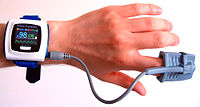
Photo from wikipedia
Background: In-laboratory, polysomnography (PSG) is the gold standard for diagnosing obstructive sleep apnea syndrome (OSAS). However, the long waiting list and sleeping at a hospital make patients hesitate to undergo… Click to show full abstract
Background: In-laboratory, polysomnography (PSG) is the gold standard for diagnosing obstructive sleep apnea syndrome (OSAS). However, the long waiting list and sleeping at a hospital make patients hesitate to undergo the examination, thereby delaying diagnosis. During coronavirus disease 2019 (COVID-19) pandemic, sleep labs are almost closed, and the delay is worsening. The home sleep test (HST) enables subjects to be tested at home, a familiar and comfortable environment, without a long waiting list. This study assessed the accuracy of a type III HST in diagnosing OSAS in the Taiwanese population and identified factors affecting the diagnostic accuracy. Methods: This retrospective study included 67 patients with clinically suspected OSAS. All patients were allocated to receive both PSG and the HST. The apnea-hypopnea index (AHI) measured through PSG was used as the standard. The sensitivity, specificity, and accuracy of the HST in diagnosing and evaluating the severity of OSAS were analyzed. Results: Among the 67 patients, no significant difference was noted in the average AHI values obtained using PSG and the HST (p = 0.103). The AHI obtained from HST was significantly correlated with that obtained from PSG, with the correlation coefficient being 0.779 (p < 0.001). The sensitivity, specificity, and accuracy of the HST in diagnosing OSAS were 94.9%, 62.5%, and 91.0%, respectively, and 80.0%, 74.1%, and 77.6% in diagnosing moderate to severe OSAS. Furthermore, the difference in AHIs measured using the two tests were positively correlated with the severity of sleep apnea. Conclusion: The HST used in preliminary screening of patients with suspected OSAS achieved an accuracy of >90%. For patients with moderate to severe OSAS, the accuracy was below 80%. Therefore, for patients who receive an OSAS diagnosis through the HST, arrangement of PSG is recommended for determining the severity of the OSAS and giving proper treatment.
Journal Title: Journal of the Chinese Medical Association
Year Published: 2022
Link to full text (if available)
Share on Social Media: Sign Up to like & get
recommendations!